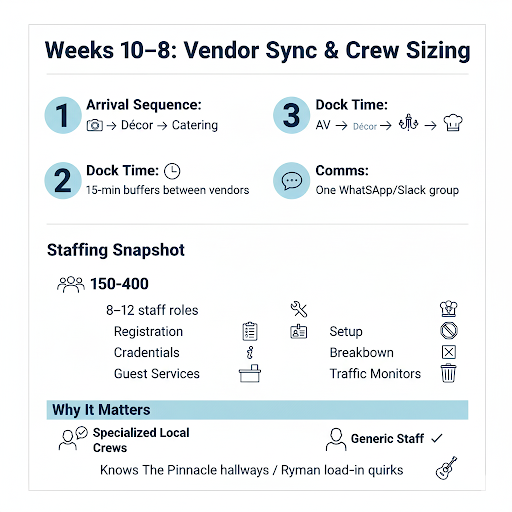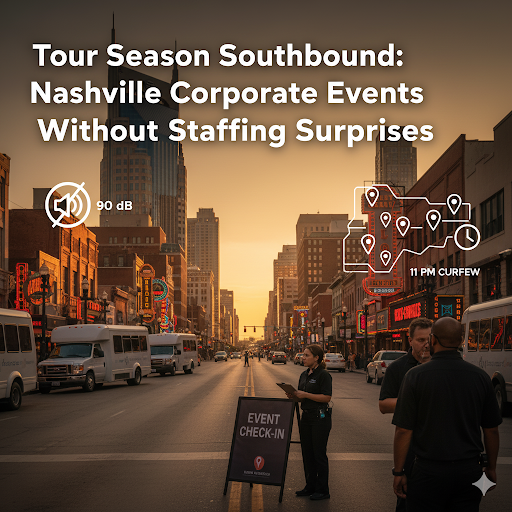Corporate event planners booking Broadway or Gulch venues often miss a critical constraint: Nashville’s downtown corridor runs on tight operational windows. Unlike the massive sprawl of convention centers in other destinations, Music City event venues are located in an easily walkable district where loading dock access, crew credentialing lead times and noise ordinance enforcement are stricter than most planners expect.
A 2024 article by the Nashville Convention & Visitors Bureau said that 68% of downtown corporate business is multi-venue (split programming, sponsor activations, or attendee shuttles between properties.) That operational complexity demands staffing clarity weeks before load-in.
The fine line between an exceptional corporate event and a credentialing delay or shuttle miscommunication or compliance violation that will derail said corporate event entirely, all comes down to one thing: staffing designed for the unique operational realities of Nashville.
Pre-Production: The 12-Week Rundown
Weeks 12–10: Establish the Corridor Map
Before selecting the crew, map your venue cluster. Nashville’s downtown venues operate under shared city ordinances but independent loading schedules. The Ryman Auditorium, The Pinnacle and JW Marriott properties all lie within a half mile of the downtown rain dock but have separate dock access windows.
Document:
- Load-in and load-out windows note that most downtown venues restrict 6 AM–10 AM and 6 PM–11 PM 8.
- Parking allocation for crew vehicles as street parking fills fast during tourist season 7.
- Wi-Fi and communication infrastructure at each venue
- Guest capacity and ADA pathways between locations
This map becomes your operational Bible. Share it with your staffing partner at this stage—not two weeks before the event. Experienced crews flag logistical friction points that planners miss.
Weeks 10–8: Vendor Sync and Crew Sizing

AV, catering, and décor vendors should be coordinated simultaneously. They all bring their own team and having the group simultaneously will bring bottlenecks.. Establish:
- Vendor arrival sequencing: AV crew first, then décor, then catering setup
- Dock time allocation: Non-negotiable 15-minute buffers between vendors
- Crew communication channels: 1 WhatsApp or slack group (no texting all over the place)
What a moderate sized corporate event (150-400 attendees) at two Nashville venues looks like: -8–12 staff roles: registration, credentials management, roaming guest services, set-up coordinators, breakdown crew and traffic flow monitors. Large crews make logistical noise; small ones miss moments.
Staffing depth matters here. In Nashville specifically, crews familiar with the venue cluster’s quirks—narrow hallways at The Pinnacle, load-in timing at The Ryman—justify their premium. Generic staff slow operations. This is why Nashville event staffing providers who specialize in the corridor understand the market’s operational rhythms in ways national staffing networks don’t.
Weeks 8–6: Credentialing and Compliance
Nashville’s downtown venues require credentialed staff. Unlike some markets where venue credentials happen at check-in, Nashville properties mandate pre-event credential submission.
Obtain from your staffing partner:
- Full legal names and driver’s license numbers for all crew
- Proof of any required background clearances
- Physical descriptions (height, distinguishing features) for credential photos
Submit to venue security and police liaison 10 days before the event. Delays here are non-recoverable—credentials are printed once.
Compliance piece: If your event involves live music, performance licensing, or vendor permits, those require separate coordination. Your staffing crew doesn’t execute these, but they do coordinate with city liaison points. A crew experienced in Nashville’s specific compliance layers catches gaps early.
Downtown Noise and Curfew Vignette: The Real Constraint
Here’s where Nashville differs from Dallas or Chicago: the downtown corridor operates under strict noise ordinances.
Broadway and the Gulch enforce a 90-decibel outdoor sound limit and an 11 PM hard curfew for outdoor programming. A corporate cocktail hour that runs long, a DJ set that cuts into curfew time, or outdoor amplified remarks—each has real enforcement risk.
One Nashville event planner we know shared this: a 400-person corporate mixer originally scheduled outdoor appetizers until 11:15 PM. The venue’s sound engineer flagged the curfew conflict. Last-minute rescheduling moved the segment indoors. No fine, no reputational damage—but that rescue only happened because her staffing team understood Nashville’s ordinance teeth.
Staffing role: Your crew acts as real-time compliance monitors. They track noise levels, manage program timing, and alert venue management to curfew creep. This isn’t fancy work—it’s expertise that prevents costly stops-and-starts.
Shuttle and Logistics Protocol: Movement Is Your Audience Experience
Multisite Corporate Events are Defined by Shuttle Logistics I Ask these questions in order to decide what type of travel is right for your delegates! A disoriented guest who stood around waiting for a bus for 20 minutes between venue A and venue B was not guests you wanted to network with, anyway.
Establish shuttle choreography 4 weeks out:
- Timing: Map exact departure windows between venues (account for 8-minute drive times and venue egress variability)
- Crew at each hub: Stationary staff at each venue who direct attendees to shuttle zones, confirm headcounts, and radio ahead to receiving venues
- Real-time comms: Ship has 10 crew A crew member from the ship talks status to both venue teams (one at a time)
A standard Nashville two venue corporate event for 250 people requires the schedule and coordination of: 2 dedicated shuttle coordinators, 2 hub staff (one per each location) and a roaming guest services lead to answer questions and field last minute changes.
Debrief Framework: Turning One Event Into Operational Library
After event, spend 30 minutes in a structured debrief with your staffing lead to set up disproportionate returns for the future
Debrief topics:
- Load-in/load-out timing: How close to windows did you cut it? Where did crews wait?
- Credential efficiency: Did pre-submission work, or were there last-minute corrections?
- Shuttle execution: Did timing hold? Where did guests bunch up or miss shuttles?
- Noise compliance: Any venue calls or late-minute adjustments?
- Staff communication: Did the Slack/WhatsApp group work, or were there missed messages?
- Vendor coordination: Where did crews overlap unproductively?
Document this. It becomes your playbook for Nashville event #2, #3, and beyond. Each debrief cuts 15–30 minutes of operational friction from your next event.
Run-of-Show Card: Your Operational North Star
A run-of-show card (laminated, 8.5″x11″) tracks every milestone:
EVENT RUN-OF-SHOW: [Corporate Event Name] | Date: [Date] | Lead Coordinator: [Name/Contact]
| Time | Venue | Activity | Crew Lead | Notes |
| 6:00 AM | Venue A | AV Load-In Begins | [Name] | Dock available until 8:00 AM |
| 7:00 AM | Venue A | Décor Setup | [Name] | Non-overlap with AV; flagging for 8 AM hard stop |
| 10:00 AM | Venue B | Credential Check-In / Registration Staff Positioning | [Name] | Credentials printed; staff briefing at 9:45 AM |
| 12:00 PM | Both | Event Begins; Shuttle monitoring active | [Name] | 90-decibel sound check completed; playlist verified |
| 2:00 PM | Venue A | Programming Transition (indoor shift if outdoor approaching 11 PM) | [Name] | Curfew buffer protocol in effect |
| 4:00 PM | Venue B | Breakdown begins (décor) | [Name] | Coordinate with vendor; AV breakdown at 4:30 PM |
| 5:30 PM | Both | Final sweep / asset accountability | [Name] | Verify all crew cleared; vehicles parked |
This card lives with your event lead and is shared with venue management. It’s not pretty—it’s operational clarity.
Checklist: The Day Before
- All staff have received detailed venue maps and logistics briefing (no exceptions)
- Parking assignments texted to each crew member with specific lot/zone instructions
- Credential badges printed and delivered to venue security
- Shuttle schedule (times, vehicle counts, driver assignments) confirmed with transportation partner
- Sound system tested for decibel compliance; music playlist pre-approved by venue
- Weather contingency for outdoor programming finalized
- Vendor arrival sequence confirmed in writing (email confirmation from each vendor)
- Communication channel (Slack/WhatsApp) active with all staff and venue points of contact
- Phone tree established: lead coordinator, each venue manager, transportation lead, one backup
- Catering staff briefed on kitchen access windows and plating station setup
Why Nashville Staffing Specificity Matters
A corporate event in Nashville isn’t just logistics—it’s corridor choreography. Crews who’ve staffed Broadway venues understand load-dock realities, credential workflows, and curfew enforcement that crews trained in sprawling convention center markets don’t automatically know.
When you partner with a staffing provider experienced in corporate events in Nashville, you’re not paying for bodies—you’re paying for operational IQ baked into crew onboarding.Great corporate events do not look or feel like a corporate event to the people who attend them. The smoothness is facilitated by weeks of pre-production, a crew with local knowledge and a run-of-show that accounts for every road bump. In Nashville, those limitations exist — and can be enforced.
And ignoring them can cost time, reputation and sometimes money. When you need to staff your next Nashville corporate event, planning is naturally an unfolding filter: does your staffing partner know the corridor–do they ask the right pre-production questions–do they own compliance details?
If they do, you’ve found the operational partner who’ll transform logistical complexity into invisible execution.

